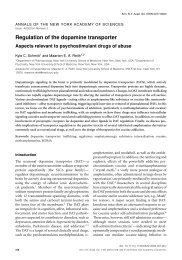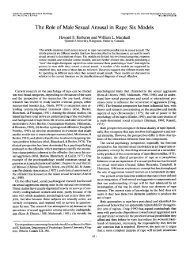Manipulation of frontal EEG asymmetry through biofeedback alters ...
Manipulation of frontal EEG asymmetry through biofeedback alters ...
Manipulation of frontal EEG asymmetry through biofeedback alters ...
Create successful ePaper yourself
Turn your PDF publications into a flip-book with our unique Google optimized e-Paper software.
Manipulating <strong>EEG</strong> <strong>asymmetry</strong> <strong>alters</strong> emotion 687<br />
Bi<strong>of</strong>eedback Training<br />
Following the film viewing and emotion rating, bi<strong>of</strong>eedback training<br />
began. 1 On the first day only, training began with a baseline<br />
session in which noncontingent feedback was delivered, with reward<br />
tones presented randomly for 20% <strong>of</strong> the time. The purpose<br />
<strong>of</strong> this session was to establish the baseline <strong>asymmetry</strong> in a traininglike<br />
environment. This baseline <strong>asymmetry</strong> was then used to compute<br />
the criterion for contingent feedback in the subsequent training<br />
trial.<br />
Five 6-min bi<strong>of</strong>eedback training blocks followed, with a 1-min<br />
break between blocks. Each block involved 150 2-s epochs. During<br />
the first second <strong>of</strong> each 2-s epoch, <strong>EEG</strong> data were sampled at<br />
256 Hz. Alpha power ~8–13 Hz! was then computed at right ~F4!<br />
and left ~F3! <strong>frontal</strong> leads using a fast Fourier transform algorithm<br />
with a Hamming window function. The difference in alpha power<br />
between right and left ~R L! was then computed and compared<br />
against the criterion value ~see below! established for that block. If<br />
the R L alpha power difference exceeded the criterion value in<br />
the desired direction, a 300 Hz reward tone was played over the<br />
audio speakers; if the criterion was not exceeded, a 150 Hz nonreward<br />
tone was played over the audio speakers. Tones were<br />
continuous, such that onset <strong>of</strong> one tone coincided with the <strong>of</strong>fset <strong>of</strong><br />
the previous tone. Epochs where ocular activity exceeded 50 mV<br />
resulted in no tone for the next 2 s, and the data from those epochs<br />
were not analyzed. Epochs where <strong>EEG</strong> activity exceeded the input<br />
range <strong>of</strong> the A-D card also halted tones for 2 s and were excluded.<br />
Following each block <strong>of</strong> 150 epochs, the mean R L value and<br />
standard deviation were calculated. The criterion value for the next<br />
training block was then defined in terms <strong>of</strong> each participant’s<br />
previous mean and standard deviation. For LEFT participants,<br />
reward tones were presented when the R L alpha value exceeded<br />
the criterion <strong>of</strong> the mean 0.85 standard deviations; for RIGHT<br />
participants, reward tones were presented when the R L alpha<br />
value was less than the criterion <strong>of</strong> the mean 0.85 standard<br />
deviations. This criterion value should, assuming a normal distribution<br />
<strong>of</strong> right–left values across the 150 epochs, result in reinforcement<br />
on approximately 20% <strong>of</strong> the trials ~Rosenfeld et al.,<br />
1995!. Moreover, by adjusting the criterion for each training block,<br />
the rate <strong>of</strong> reinforcement should remain relatively constant, regardless<br />
<strong>of</strong> whether participants are altering their right–left <strong>asymmetry</strong><br />
scores. This strategy <strong>of</strong> constantly adjusting the training criterion<br />
should keep the rate <strong>of</strong> reward, which itself could alter emotion,<br />
comparable for all subjects regardless <strong>of</strong> their success in altering<br />
<strong>EEG</strong> <strong>asymmetry</strong>, and regardless <strong>of</strong> whether subjects were trained<br />
in the LEFT or RIGHT direction.<br />
During training, participants were told that bi<strong>of</strong>eedback training<br />
involved using the activity <strong>of</strong> their brains to cause a computer<br />
to generate high or low tones, and that they should try to make the<br />
high tone stay on. Participants were also informed that occasionally<br />
the tone might stop altogether and, that if this happens, they<br />
should simply resume their focus on keeping the high tone on.<br />
Participants were never explicitly told that the bi<strong>of</strong>eedback was<br />
contingent on <strong>asymmetry</strong>, nor were they told that excessive ocular<br />
activity caused the “time outs.” No explicit verbal feedback was<br />
provided to participants concerning their performance. Following<br />
each day <strong>of</strong> training, participants completed the Positive and Negative<br />
Affect Schedule—state version ~PANAS; Watson, Clark, &<br />
Tellegen, 1988! to assess current mood.<br />
1 Bi<strong>of</strong>eedback training was controlled by a PC-compatible computer<br />
program generously provided by Peter Rosenfeld.<br />
For the second <strong>through</strong> fifth days, five 6-min bi<strong>of</strong>eedback<br />
training blocks were conducted as previously described. The criterion<br />
value for the first block <strong>of</strong> each day was based upon the<br />
mean and standard deviation <strong>of</strong> the previous day’s final block. On<br />
the fifth and final day, following the five training blocks, participants<br />
once again viewed the three short silent films in one <strong>of</strong> two<br />
orders randomized across participants, and rated their emotional<br />
responses following each film.<br />
Psychophysiological Recording and Quantification<br />
Electroencephalographic ~<strong>EEG</strong>! and electrooculographic signals<br />
were recorded on all five days. Additionally, during the film clips<br />
shown on the first and the fifth day, facial EMG signals over<br />
corrugator and zygomatic muscle regions were recorded. <strong>EEG</strong><br />
signals were processed as described above in the section describing<br />
bi<strong>of</strong>eedback training, whereas EMG signals were processed as<br />
described below.<br />
Recording. <strong>EEG</strong> signals were recorded with tin electrodes in a<br />
stretch-lycra cap from sites F3 and F4 referenced on-line to Cz. 2<br />
Electrode impedances, for these <strong>EEG</strong> leads as well as all other<br />
leads to be described below, were less than 5 KV, and F3 and F4<br />
were within 1 KV <strong>of</strong> one another. <strong>EEG</strong> signals were amplified by<br />
a factor <strong>of</strong> 20,000 with AC differential amplifiers ~bandpass 0.1–<br />
30 Hz! and digitized at 256 Hz. Facial EMG signals were recorded<br />
with miniature Ag0Ag-Cl electrodes attached bilaterally in pairs<br />
over the corrugator supercilii and zygomaticus major muscle regions,<br />
using placements as described by Fridlund and Cacioppo<br />
~1986!. Bipolar EMG signals were amplified by a factor <strong>of</strong> 20,000<br />
with AC differential amplifiers ~bandpass 0.1 and 1,000 Hz!, and<br />
digitized continuously at 1024 Hz. To monitor eye movements,<br />
Ag-AgCl electrodes were affixed to the superior orbit and inferior<br />
orbit ~amplification 5 K, bandpass 0.1–30 Hz! and digitized at<br />
256 Hz.<br />
Quantification <strong>of</strong> EMG. EMG data, recorded only on Day 1<br />
and Day 5 during the presentation <strong>of</strong> the three films, were highpass<br />
filtered ~102 amplitude frequency 10 Hz!, and rectified<br />
<strong>of</strong>f-line. Signals were then segmented into 2-s epochs. The mean<br />
rectified activity across all artifact-free epochs for a given film clip<br />
was taken as the index <strong>of</strong> EMG activity. These indices were then<br />
Z-transformed within each participant and each muscle region<br />
~using the six data points—three films before training and three<br />
after!; Z-transformations preserve the pattern <strong>of</strong> response for each<br />
participant across films and time, while minimizing overall differences<br />
between participants in muscle activity.<br />
Results<br />
<strong>EEG</strong> Training Effects<br />
Frontal <strong>asymmetry</strong> scores ~R L alpha! were first baseline adjusted<br />
for each participant, reflecting changes in <strong>asymmetry</strong> from<br />
2 Several reference montages have been used in the research literature<br />
<strong>of</strong> <strong>EEG</strong> <strong>asymmetry</strong> and emotion, and the correspondence between <strong>asymmetry</strong><br />
scores from data collected using different montages can vary substantially<br />
~see Reid, Duke, & Allen, 1998!. Although it is increasingly<br />
common, and desirable, to analyze <strong>EEG</strong> <strong>asymmetry</strong> data derived from<br />
several <strong>of</strong>f-line re-referenced montages ~e.g., computer-averaged mastoids,<br />
average reference, Cz reference!, this strategy to date has not demonstrated<br />
a clear superiority <strong>of</strong> one reference montage ~Reid et al., 1998!. Given that<br />
in the present study feedback was to be presented on-line, the feedback<br />
needed to be provided on the basis <strong>of</strong> <strong>EEG</strong> <strong>asymmetry</strong> scores derived from<br />
a single reference montage.










